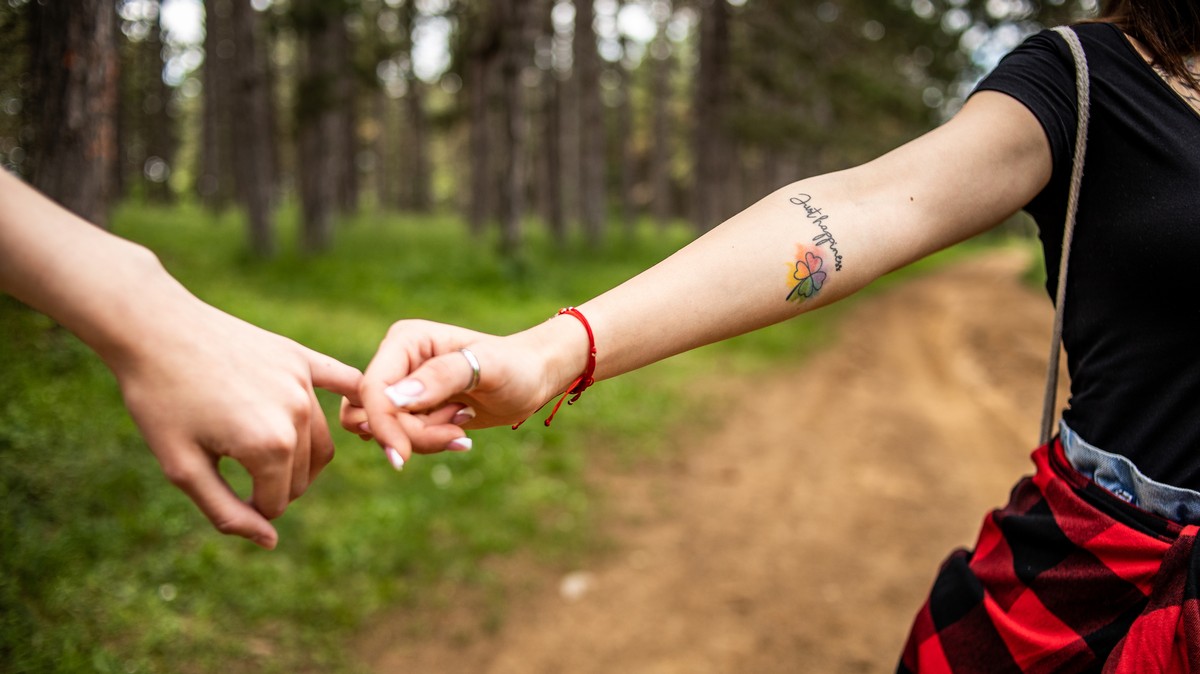
We’re all looking for some explanation of why we are the way we are. In an ideal world, we’d all have access to the minds of doctors, psychologists, and researchers whose expertise could provide us with concise insight into our personality and a prescription for a path forward. Most of us, though, will never quite get that opportunity—if one even exists.
Instead, we turn to the language that pop culture and social media have afforded us. And many concepts from the medical and academic world have seeped through, from books like The Body Keeps the Score and Attached: The New Science of Adult Attachment. Both of these emphasize attachment theory, a concept developed in the 1950s by psychologists John Bowlby and Mary Ainsworth, originally positing that the relationship between mother and young child could dictate said child’s future sociability.
Today, discussions of attachment theory online have served to detail why a person might act or feel a certain way in relationships, retaining the idea that our parents have made us this way for life. It’s something that mainstream news outlets—including this one—have been paying more attention to over the last few years, though interest seems to be surging again. On TikTok, for example, there are hundreds of videos about having an “anxious attachment style” due to a lack of consistency and care in childhood, rendering people hypervigilant of their partner’s every action.
But according to Pascal Vrticka, Assistant Professor at the Department of Psychology, University of Essex (Colchester, UK) and Coordinating Board President of the Special Interest Research Group “Social Neuroscience of Human Attachment” situated within the Society for Emotion and Attachment Studies (SEAS), this deterministic attitude may not be the most accurate or helpful way of interpreting attachment. It isn’t entirely wrong, he explains, but there’s more to the story.
“A good general definition of attachment may be that it reflects our expectations and predictions about future social interactions and relationships, based on our past and current social interactions and relationships,” Vrticka says. Recent research and theory suggest that we are not as bound to our past as we may initially have thought. “One realization of modern attachment theory is that attachment is not something set in stone that predetermines all of our life,” he says. Except in developmental or relational trauma cases that can leave lasting scars and require professional help, our attachment style often shifts throughout life. Some patterns do indeed emerge early through our caregivers, others may have a genetic component, but even these are not necessarily fixed.
Below, Vrticka explains how attachment theory can help us understand our relationships and how they form without serving as a permanent label of who we are—in a time when TikTok might be quick to convince us otherwise.
VICE: What do practical applications of attachment theory look like
Pascal Vrticka: One possible application is that we can learn about ourselves and our relationship history, how this has shaped our current relationships and how we might want to reflect on that to maybe have different relationships in the future. Because one realization of modern attachment theory is that attachment is not something that is set in stone and predetermines all of our life. Of course, many of our attachment patterns are established early, and we keep some of their aspects throughout our entire life. However, it doesn’t mean that we cannot change and are a victim of these patterns—unless we experienced strongly adverse experiences that left us traumatized and needing professional help.
“Of course, many of our attachment patterns are established early, and we keep some of their aspects throughout our entire life. However, it doesn’t mean that we cannot change and are a victim of these patterns.”
A second possible application is that attachment theory can help us understand how relationships with others emerge and how we can best maintain them. This is particularly important early in life, where attachment theory and research can help us support parents and children to develop the most beneficial attachment or bonding patterns, depending on the direction you’re looking at. But attachment remains important throughout our entire life as we form new bonds with peers, romantic partners and eventually our own children.
A third possible application is to use attachment theory in a therapeutic context, to be there for people who have attachment issues and to help them overcome these issues.
How common is it to have issues with one’s attachment style?
I think everybody has “attachment issues,” at least with some people. And that is pretty normal. We do not have only one attachment style that applies to everybody—every social interaction and relationship is unique. We can have multiple different attachments to different people at the same time. And then, of course, we sometimes have more secure tendencies with one person, and at the same time, we have a bit more avoidant or anxious tendencies with somebody else.
As long as these more insecure tendencies are context-dependent—as long as they are linked to a specific person in a specific situation and we don’t feel too strongly affected by them, or we even feel that they are useful and that they help us manage this kind of relationship—then they are not necessarily an issue. Attachment insecurities only become an issue if they start to negatively influence many aspects of our life and make social interactions harder across different relationships.
It would be strange and unhealthy to have the same level of attachment with everyone you interact with.
There used to be the general impression that we form our attachment style mainly from our interactions with our mom. That was the initial theory put forward in the 1950s and 1960s. The assumption was that one caregiver, mainly the mother, determines our attachment style and that we would use the same style for the rest of our life across all our relationships.
But things have strongly changed since then, and recent research on adult attachment–nicely summarized here–clearly shows this is not the case. Our attachment style is formed through interactions with many different people—including dads, grandparents, etc.—and it is dynamic. It can and does change in quite short time frames, depending on significant life events. Furthermore, as for everything else, we also have some genetically inherited tendencies regarding our attachment style. But that doesn’t mean that our attachment style cannot change or is predetermined. Attachment is a prototypical example of a gene-by-environment interaction between nature and nurture.
There’s a lot of interest in anxious attachment styles, specifically. Can you explain what that is?
The theory goes that an anxious attachment style develops when, in your early interactions with others, these others are unpredictable or inconsistently responsive. So let’s say you are distressed, approach somebody, and want to be comforted. You do that in the same way repeatedly, and once you get a very comforting response, you’re soothed, and you get a hug—but then, another time in the same situation, you get scolded and rejected. Under such circumstances, you never know what will happen when you interact with that person the next time. But you long for the comforting kind of interaction that you sometimes get—because it makes you feel good, and it’s, of course, exactly what our attachment system is made for, to get supported by somebody, to have somebody around us to whom we feel socially connected and who can help us co-regulate our emotions.
From there, you start to develop a kind of hypersensitivity or hypervigilance. You always monitor the environment, whether it will be a situation where you will be comforted or not. And because of that, you also are less able to develop your self-soothing skills. You will probably be more often in a more highly activated state. You will be more vigilant and hypersensitive to possible signs of rejection.
Why might this topic appeal to people on social media, particularly in a relationship context?
I can only speculate here because that’s not exactly what my research is about—I’m mostly working on the neurobiological basis of attachment. But maybe it’s because we are living in a time of quite high uncertainty, generally speaking. We are just re-emerging from the COVID-19 pandemic and are increasingly facing the consequences of climate change. There is a war raging in Ukraine, etc. So I think it might be that right now, we are more insecure or more uncertain about many different things, which can also affect how secure we feel in our relationships.
Another option is that, when we are dating, it might be that we’re living in a time where everybody has a cell phone, and everybody always thinks that we have to be very responsive and available all the time. And that’s something that can fuel attachment-related anxiety. If you send a WhatsApp message or text that you know the other person gets right away, why are they not replying? Your mind starts spinning because that’s just the nature of this way of communication.
You mentioned earlier that our attachment styles can change over time. Are the uncertainty of recent years and online communication two things that might cause these changes?
Oh, yes, absolutely. Because, you know, our current attachment is influenced not only by our past but also by our current interactions. For example, for two years, we didn’t have too many in-person social interactions, and now we are returning to the social world again and experiencing interactions a little bit like new. We might be more secure and outgoing and really enjoy it, but we might also be more anxious. We might feel as if we missed something and that we no longer know how to behave, feel, and think in these situations. There is also evidence that particularly an anxious attachment style was associated with worse mental health outcomes during COVID-19. It therefore seems quite likely that our attachment style was related to our ability to cope with the pandemic, and it may even be that the pandemic in turn has influenced our attachment style.
Much of the discussion on TikTok, for example, centers attachment theory in our childhood experiences. But it seems as though our recent experiences may be just as influential.
It’s best to view our attachment style as a combination of our childhood experiences and our current experiences because our early experiences will always be there somewhere, but not always to the same degree. They won’t necessarily influence all relationships we have right now and in the future. We can have a very different attachment to a parent and to a romantic partner, spouse, etc.
“Our early experiences will always be there somewhere, but not always to the same degree.”
What do you think might be getting lost in the pop culture interpretation of attachment theory?
Sometimes people say it’s about being more or less attached or having a certain intensity or strength of attachment. However, attachment theory is really much more concerned with interaction and relationship quality. We can have very few interactions with somebody but still have a very high-quality attachment bond to that person. SEAS has recently collated very useful explanations of attachment theoretical concepts to resolve some common misconceptions including this one.
Also, it takes time to develop an attachment bond with somebody, and not everybody we interact with is or will become an attachment figure. Attachment is a selective, enduring bond with somebody who provides care and protection when we need it most. Usually, not many people in our life hold such a specific role. And the mutual trust such a relationship involves is not easily established and needs constant nourishment.
Finally, attachment is important, but it’s not everything. Attachment is a personality trait, especially if we look at it from a social psychology perspective in adulthood. It’s one trait amongst several others, and there are other factors, like our health, socioeconomic status, etc. that also determine our overall quality of life.

